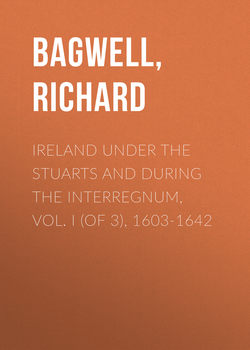Читать книгу Ireland under the Stuarts and during the Interregnum, Vol. I (of 3), 1603-1642 - Bagwell Richard - Страница 1
PREFACE
ОглавлениеThese volumes have been written at such times and seasons as could be made available during an active life in Ireland, and this may induce critics to take a merciful view of their many shortcomings. I have been diligent, but there is still much extant manuscript material which I have been unable to use. Ireland is the land of violent and persistent party feeling, and no party will be pleased with the present work, for I hold with an ancient critic that the true function of history is to bring out the facts and not to maintain a thesis. If I am spared to finish the third volume, it will bring the narrative down to the Revolution, and will contain chapters on the Church or Churches and on the social state of Ireland.
The dates of all documents relied on have been given, and unless it is otherwise stated they are among the Irish State Papers calendared from 1603 to 1660. Many papers, chiefly, but not exclusively, from the Carte manuscripts, were printed by Sir J. T. Gilbert in the ‘Contemporary History of Affairs in Ireland,’ or in the ‘History of the Confederation and War in Ireland.’ As these collections are more generally accessible than the Bodleian Library, I have referred to them as far as they go. The ‘Aphorismical Discovery,’ which forms the nucleus of the first, is cited under that title, and the narrative of Bellings in the second under his name. The original Carte papers at Oxford have been often consulted, as well as the transcripts in the Public Record Office, while the manuscripts in the British Museum and in Trinity College, Dublin, have not been neglected. In the case of old tracts and newsletters, of which I have read a great many, dates and titles are given.
The late Lord Fitzwilliam did not consider it consistent with his duty to let Dr. Gardiner see the Strafford correspondence preserved at Wentworth Woodhouse, and my application to his successor has also been refused. No restriction seems to have been imposed on the editors of Laud’s works, of which the last instalment was published as late as 1860. All the Archbishop’s letters are printed, Strafford’s being omitted only because they would have taken too much room. In 1739 Dr. William Knowler, working under Lord Malton’s directions, published the well-known Strafford Letters, and Mr. Firth has thrown fresh light upon them by printing some of the editor’s correspondence in the ninth volume of the ‘Camden Miscellany.’ ‘There is,’ Knowler wrote, ‘four or five times the number of letters uncopied for one transcribed, and yet I believe those that shall glean them over again won’t find many things material omitted.’ Yet Laud’s editors thought it worth while to publish a good deal of what had been left out, and probably there is still something to be done.
I have made some examination of the famous depositions in Trinity College, Dublin, concerning the rebellion of 1641, but it is unnecessary to repeat Miss Hickson’s arguments, which appear to me conclusive. The documents may be pronounced genuine in the sense that they really are what they profess to be, but they are all more or less ex parte statements, and the witnesses were not cross-examined. Deductions may be made on these grounds, especially in the case of numerical estimates, but there is a vast mass of other evidence as to the main facts. The matter is discussed pretty fully in Chapter XX.
It is unnecessary to describe here the various contemporary histories and memoirs referred to in the text and notes. Sir Richard Cox’s ‘Hibernia Anglicana’ should be used with caution. Cox was a strong partisan, but he was not a liar, and he wrote at a time when there were still living witnesses.
The maps at the beginning of each volume are intended as helps to the reader, and make no pretension to completeness. Fuller details as to the various colonies or plantations may be found in Mr. Dunlop’s map, No. 31 in the Oxford Historical Atlas. As to the short-lived Cromwellian settlement much may be learned from the map in Gardiner’s ‘Commonwealth and Protectorate,’ iii. 312, and from that in Lord Fitzmaurice’s ‘Life of Petty.’ The more lasting arrangements made after 1660 will be the subject of full discussion in my third volume. The innumerable sieges, battles and skirmishes from 1641 to 1653 may be traced in any large map of Ireland, and cannot be shown in a small one. The state of affairs at the critical moment of the first truce in 1643 is illustrated by the map in Gardiner’s ‘Great Civil War,’ i. 264.
My best thanks are due to Mrs. Shirley for lending me fourteen volumes of tracts concerning the rebellion from the library at Lough Fea. They have been very useful.
I received some valuable hints from my friend, the late C. Litton Falkiner, whose untimely death is a loss to Ireland.
Marlfield, Clonmel:
December 26, 1908.
